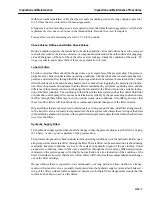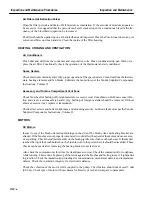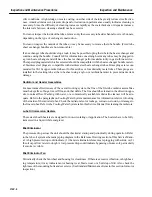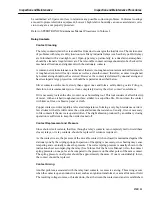
Inspection and Maintenance
Inspection and Maintenance Procedures
IMP–9
Pipe Couplings
Check the couplings for oil leakage due to aging and heat. Replace seals as needed.
Lubricate seals prior to each assembly of seals.
COOLING WATER SYSTEM
Cooling System Checks
Cooling system fouling, with consequent performance degradation, must be checked periodically, even
though the system is properly rust inhibited. Removing the water side head of the lube oil heat exchanger
and inspecting the tubes will indicate the general amount of fouling that has occurred in the whole sys-
tem. Fouling of the fin-tube radiators will probably be the most severe, since the tubes are the smallest
in the system.
A maximum of ten percent of the tubes in each heat exchanger can be plugged to eliminate water leaks.
The leaks in the water-to-air heat radiator may be repaired at a local automotive radiator repair shop.
This method is preferred to plugging the tubes, since the system performance is not seriously affected.
Plugging the heat exchangers will reduce system performance and result in more frequent cleaning.
Cleaning of the cooling water system can be accomplished as follows:
1. Use either two or three percent by volume of formic acid, or three to four percent by volume of sul-
famic acid to fill the cooling water system. Muriatic acid is not allowed.
2. Circulate the solution through the cooling water system for two hours. Then drain the system.
3. Flush the system completely with water. If any discoloration remains, repeat the cleaning procedure.
4. After the system has been properly cleaned, refill with pure water and the recommended amount
of corrosion inhibitor or anti-freeze mixture. For detailed instructions, refer to the Fluids Specifica-
tion Tab in Volume II of this Service Manual.
Flow Checks
The closed cooling water system has several sharp-edged orifice plates mounted in the orifice flanges.
These orifices are used to balance the pressure drop in parallel flow circuits. They also may be used to
measure system flow rates. Measurement of system flow rates is extremely important for troubleshoot-
ing, if problems develop. Design flow rates for the water circuits with the temperature-actuated valves
in the open position are listed on Cooling Water Schematic Piping Diagram, in the Outlines and Diagram
Tab in the Service Manual. These design flow rates are based on 100 percent turbine speed. If the turbine
is not operating at rated speed, calculate a correct flow as follows:
Flow at actual speed
Actual Speed
Rated Speed
flow at rated speed.
When the flow check is made, it is suggested that a single test gauge be installed to read the pressures
both upstream and downstream of the orifice. The gauges should be valved so that each pressure can
be read individually. This procedure will eliminate gauge errors which could occur when two separate
gauges are used. Runs of pressure lines should be as short as possible.
Summary of Contents for MS6001B
Page 2: ...Gas Turbine Inspection and Maintenance GEK 107048 I 2 THIS PAGE INTENTIONALLY LEFT BLANK ...
Page 4: ...Inspection and Maintenance Note THIS PAGE INTENTIONALLY LEFT BLANK ...
Page 13: ...INSERT TAB INTRODUCTION ...
Page 14: ......
Page 25: ...INSERT TAB STANDARD PRACTICES ...
Page 26: ......
Page 87: ...INSERT TAB AUXILIARY CONTROLS SYSTEMS MAINTENANCE ...
Page 88: ......
Page 133: ...INSERT TAB SCHEDULED TURBINE MAINTENACE ...
Page 134: ......
Page 157: ...INSERT TAB COMBUSTION INSPECTION ...
Page 158: ......
Page 239: ...INSERT TAB HOT GAS PATH INSPECTION ...
Page 240: ......
Page 313: ...INSERT TAB MAJOR INSPECTION ...
Page 314: ......
Page 316: ...Inspection and Maintenance GEK 107048 Major Inspection 2 THIS PAGE INTENTIONALLY LEFT BLANK ...
Page 363: ...INSERT TAB MAINTENANCE FORMS ...
Page 364: ......
















































